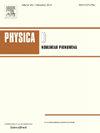Machine learning-based estimation of correlation dimension from short chaotic time series
IF 2.9
3区 数学
Q1 MATHEMATICS, APPLIED
引用次数: 0
Abstract
Fractal dimension is an important tool for describing complex systems, while correlation dimension is a type of fractal dimension of time series. It can give a more accurate understanding of the characteristics of the system and plays an important role in practical applications. To address the challenge of accurately calculating the correlation dimension of short chaotic data, this paper explores a machine learning-based approach. This method leverages the universal approximation theory of neural networks to compare the Long Short-Term Memory (LSTM) network, the Transformer architecture, and the Backpropagation (BP) network in deep learning, and then selects the optimal approach. Ultimately, the method integrates the backpropagation (BP) neural network with a genetic programming (GP) algorithm for the calculation of the correlation dimension, thereby constructing a novel model. This method aims to expand the volume of chaotic short data and thereby better utilize data information. Initially, a BP neural network with ten hidden layer neurons is constructed, combined with the calculation of correlation dimension to form a new method. Subsequently, simulations are conducted on various commonly encountered chaotic systems, including Lorenz, Hénon, Chen, Logistic systems, solar activity time series and daily female births time series. And their mean squared error (MSE) values are recorded after data augmentation. Finally, the correlation dimensions of these expanded data sets are recalculated and compared with their original values. The findings reveal a remarkable proximity to the theoretical values, thereby validating the method's efficacy in augmenting chaotic short-term sequences. This approach not only enhances the utilization of original chaotic time series data but also paves the way for extracting deeper insights and greater value from short chaotic data.
基于机器学习的短混沌时间序列相关维数估计
分形维数是描述复杂系统的重要工具,而相关维数是时间序列分形维数的一种。它可以更准确地了解系统的特性,在实际应用中具有重要作用。为了解决短混沌数据相关维数的精确计算问题,本文探索了一种基于机器学习的方法。该方法利用神经网络的通用逼近理论,对深度学习中的长短期记忆(LSTM)网络、Transformer架构和反向传播(BP)网络进行比较,然后选择最优方法。最后,该方法将反向传播(BP)神经网络与遗传规划(GP)算法相结合,用于计算相关维数,从而构建了一个新的模型。该方法旨在扩大混沌短数据的容量,从而更好地利用数据信息。首先构造一个包含10个隐层神经元的BP神经网络,并结合相关维数的计算形成一种新的方法。随后,对各种常见的混沌系统进行仿真,包括Lorenz, h, Chen, Logistic系统,太阳活动时间序列和每日女性出生时间序列。并记录数据增强后的均方误差(MSE)值。最后,重新计算这些扩展数据集的相关维数,并与原始值进行比较。结果显示与理论值非常接近,从而验证了该方法在增强混沌短期序列中的有效性。该方法不仅提高了原始混沌时间序列数据的利用率,而且为从短混沌数据中提取更深刻的见解和更大的价值铺平了道路。
本文章由计算机程序翻译,如有差异,请以英文原文为准。
求助全文
约1分钟内获得全文
求助全文
来源期刊

Physica D: Nonlinear Phenomena
物理-物理:数学物理
CiteScore
7.30
自引率
7.50%
发文量
213
审稿时长
65 days
期刊介绍:
Physica D (Nonlinear Phenomena) publishes research and review articles reporting on experimental and theoretical works, techniques and ideas that advance the understanding of nonlinear phenomena. Topics encompass wave motion in physical, chemical and biological systems; physical or biological phenomena governed by nonlinear field equations, including hydrodynamics and turbulence; pattern formation and cooperative phenomena; instability, bifurcations, chaos, and space-time disorder; integrable/Hamiltonian systems; asymptotic analysis and, more generally, mathematical methods for nonlinear systems.
 求助内容:
求助内容: 应助结果提醒方式:
应助结果提醒方式:


